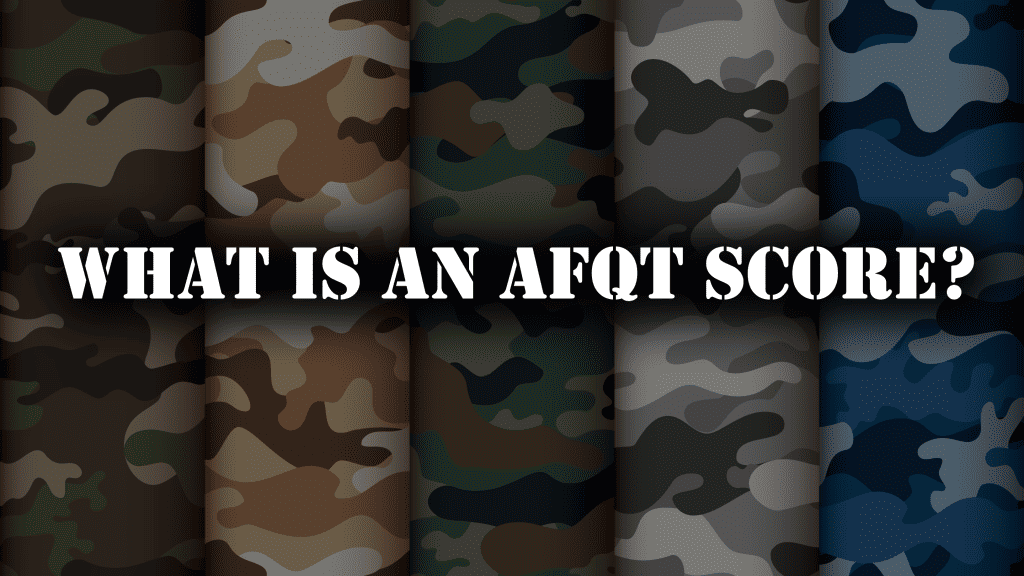What is an AFQT Score and How Does it Differ from ASVAB? Considering a military career opens up a world of opportunities, but it also comes with it’s own unique set of challenges. If you are considering joining the Armed Forces, you’ve likely encountered a myriad of acronyms, and two of the most critical ones when you are getting ready to join are AFQT and ASVAB. In this article, we’ll discuss the difference between an AFQT score and an ASVAB score.
The Armed Forces Qualification Test (AFQT) is a score composed from four specific subtests that are included in the overall ASVAB (Armed Services Vocational Aptitude Battery) test. Your AFQT score is used to determine your eligibility to enlist in the Armed Forces where as scores from the ASVAB help determine which jobs you qualify for.

Understanding the Difference Between ASVAB and AFQT
Let’s look at the ASVAB first.
The Armed Services Vocational Aptitude Battery (ASVAB), is a 225 question test that someone interested in joining the military takes before they can enlist. The test itself consists of nine subtests. The subtests cover everything from general sciences to mathematical knowledge and reading comprehension among other subjects.
Is the ASVAB hard? Learn more about the ASVAB in our recent article.
The nine (9) subtests that make up the ASVAB:
- General Sciences (GS)
- Arithmetic Reasoning (AR)*
- Mathematics Knowledge (MK)*
- Word Knowledge (WK)*
- Paragraph Comprehension (PC)*
- Electronics Information (EI)
- Auto and Shop Information (AS)
- Mechanical Comprehension (MC)
- Assembling Objects (OC)
When you take the ASVAB, each subtest is graded and you are given a “line score” as a result. A line score is simply your specific score from that particular subtest. Each of these subtests are graded and you receive an individual line score for each of the nine subtests.
The AFQT, Armed Forces Qualification Test, is derived from a formula that only includes four of those subtests. Those four subtests are Arithmetic Reasoning, Mathematics Knowledge, Word Knowledge and Paragraph Comprehension.
It’s important to note that the AFQT is not a separate test but instead is compiled from scores on four specific subtests of the ASVAB. You take the ASVAB, not the AFQT. The AFQT, however, is derived from your “line scores” from four aforementioned subtests.
Here is a video from our YouTube Channel that explains this a bit more in depth:

How is the AFQT Score Calculated?
The four line scores from those subtests are then added to the following formula: 2VE + AR + MK
Let’s breakdown that formula.
The VE in the formula stands for Verbal Expression and represents two line scores; Word Knowledge and Paragraph Comprehension. You add those two line scores together and then double that number.

In the past, VE used to be it’s own subtest but over time, the ASVAB evolved this subtest into two unique subtests to better understand a candidates abilities.
After you double the VE score, you then add the two line scores of Arithmetic Reasoning and Mathematics Knowledge to come up with what they call a “raw” AFQT Score.
This raw AFQT score is then compared with other test takers as a percentile. Notice this is a percentile not a percentage score.
Let’s say someone gets a 45 on their AFQT. That doesn’t mean they answered 45% of the questions on the ASVAB correctly. A 45 AFQT means they did as good or better than 45% of the people who took the test based on their “reference group”.
Since it’s a percentile score, the AFQT is reported as a percentile between 1 and 99. You can’t get a zero on the AFQT and you also can’t get a 100.
What is an AFQT reference group?
When you take the ASVAB, your performance is evaluated and compared to a “reference group”. This reference group consists of a sample of participants from the PAY97 study. The study was an official national norming that was done in 1997 and implemented in 2004.
Below is some information about the PAY97 but you can also read the full report on the Bureau of Labor Statistics website
The ASVAB underwent its last norming process based on a sample of young individuals who participated in the Profile of American Youth study conducted in 1997 (PAY97). This collaborative effort involved the Departments of Defense and Labor, with the objective of drawing samples of youth and having them complete the ASVAB. Two distinct samples were drawn for the purpose of developing norms for specific programs:
- Enlistment Testing Program (ETP): This operational version of the ASVAB is used to assess and screen young individuals for military service eligibility. The ETP sample included approximately 6,000 American youth aged 18-23, representing the prime enlistment pool as of June 1, 1997. To ensure adequate representation, Hispanic and Non-Hispanic Black youth were intentionally oversampled.
- Career Exploration Program (CEP): The CEP offers the ASVAB free of charge to educational institutions across the country to assist young individuals in planning their future careers. The CEP sample comprised around 4,700 students who anticipated enrolling in grades 10, 11, or 12 in the fall of 1997.
The norming groups were established through a sampling of housing units, encompassing all such units within the 50 states and the District of Columbia. Interviewers conducted screenings in approximately 75,000 households to identify eligible youth within the target age range. When eligible youth were identified, additional demographic information was gathered, and they were offered the opportunity to take the CAT-ASVAB at a local Sylvan Testing Center, with a monetary incentive of $75. The participation rate was 75 percent among those in the CEP sample and 77 percent among ETP sample members.
Since each participant in the PAY97 study was selected with known probability, it became possible to weight the cases in a manner that ensured the weighted sample accurately represented the population concerning key demographics of interest, such as age, race/ethnicity, gender, and education. The selection methods employed, coupled with post-stratification weights, provided confidence that the results obtained from both groups (ETP and CEP) accurately reflected the overall populations of 18 to 23-year-old youth and 10th through 12th graders, respectively. Consequently, norms were established for these two groups, allowing individual ASVAB results to be reported in terms of how they compared to all youth within the applicable populations.
Minimum ASVAB/AFQT Scores by Military Branch
When considering joining the military, on of the most important factors to consider is the minimum ASVAB score required by branch of the armed forces. Each branch will set their own standards, reflecting the unique demands and qualifications needed for various roles within that branch.
Note that these minimum scores are subject to change at any time and we’ve linked each the branches to their official guidelines.
AIR FORCE minimum ASVAB score – 31
COAST GUARD minimum ASVAB score – 40
MARINE CORPS minimum ASVAB score – 31

Specific jobs in the military also require particular subtest line scores to qualify. You won’t be able to be an aircraft mechanic if you score low on the Mechanical Comprehension (MC) subtest. Conversely, if you score very high on the Mechanical Comprehension (MC) subtest but low on the four subtests that make up your AFQT score, you may not be eligible for military service all together.
The key here is that all aspects of the ASVAB are important, not just the portion that makes up the AFQT section.
In Conclusion
We hope this article has been a valuable resource in demystifying the world of AFQT and ASVAB scores. Your journey toward a military career is a significant and rewarding endeavor, and we’re here to provide the information and guidance you need.
If you have any further questions or need assistance with your ASVAB preparation or any other aspect of your military path, please don’t hesitate to reach out. We’re dedicated to supporting you in your aspirations, and we wish you the best of luck as you embark on this remarkable journey of service to our nation.
Recent Posts
We often get asked “What is on the ASVAB test?” So, we decided to create a centralized resource that breaks down each section of the ASVAB. The Armed Services Vocational Aptitude...
For the most part, the Armed Services Vocational Aptitude Battery (ASVAB) isn’t hard to pass per se. But, that doesn’t mean you can walk into the test without preparing or studying for it....
